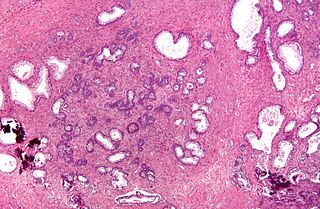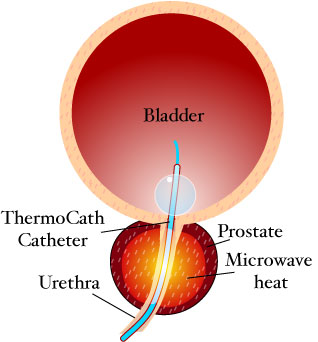Related Research Articles

Benign prostatic hyperplasia (BPH), also called prostate enlargement, is a noncancerous increase in size of the prostate gland. Symptoms may include frequent urination, trouble starting to urinate, weak stream, inability to urinate, or loss of bladder control. Complications can include urinary tract infections, bladder stones, and chronic kidney problems.

Urinary retention is an inability to completely empty the bladder. Onset can be sudden or gradual. When of sudden onset, symptoms include an inability to urinate and lower abdominal pain. When of gradual onset, symptoms may include loss of bladder control, mild lower abdominal pain, and a weak urine stream. Those with long-term problems are at risk of urinary tract infections.

Transurethral resection of the prostate is a urological operation. It is used to treat benign prostatic hyperplasia (BPH). As the name indicates, it is performed by visualising the prostate through the urethra and removing tissue by electrocautery or sharp dissection. It has been the standard treatment for BPH for many years, but recently alternative, minimally invasive techniques have become available. This procedure is done with spinal or general anaesthetic. A triple lumen catheter is inserted through the urethra to irrigate and drain the bladder after the surgical procedure is complete.The outcome is considered excellent for 80–90% of BPH patients. The procedure carries minimal risk for erectile dysfunction, moderate risk for bleeding, and a large risk for retrograde ejaculation.

Prostatectomy is the surgical removal of all or part of the prostate gland. This operation is done for benign conditions that cause urinary retention, as well as for prostate cancer and for other cancers of the pelvis.
Alpha-1 blockers constitute a variety of drugs that block the effect of catecholamines on alpha-1-adrenergic receptors. They are mainly used to treat benign prostatic hyperplasia (BPH), hypertension and post-traumatic stress disorder. Alpha-1 adrenergic receptors are present in vascular smooth muscle, the central nervous system, and other tissues. When alpha blockers bind to these receptors in vascular smooth muscle, they cause vasodilation.
Nocturia is defined by the International Continence Society (ICS) as “the complaint that the individual has to wake at night one or more times for voiding .” The term is derived from Latin nox, night, and Greek [τα] ούρα, urine. Causes are varied and can be difficult to discern. Although not every patient needs treatment, most people seek treatment for severe nocturia, waking up to void more than 2–3 times per night.

Tamsulosin, sold under the brand name Flomax among others, is a medication used to treat symptomatic benign prostatic hyperplasia (BPH) and chronic prostatitis and to help with the passage of kidney stones. The evidence for benefit with a kidney stone is better when the stone is larger. It is taken by mouth.
Transurethral needle ablation is a technique that uses low energy radio frequency delivered through two needles to ablate excess prostate tissue. A cystoscope/catheter deploys the needles toward the obstructing prostate tissue and is inserted into the urethra directly through the penis under local anesthetic before the procedure begins. The energy from the probe heats the abnormal prostate tissue without damaging the urethra. The resulting scar tissue later atrophies, reducing the size of the prostate which in turn reduces the constriction of the urethra. It can be done with a local anesthetic on an outpatient basis. It takes about an hour to perform the procedure. It takes about 30 days for the ablated prostate tissue to resorb.
Prostatic congestion is a medical condition of the prostate gland that happens when the prostate becomes swollen by excess fluid and can be caused by prostatosis. The condition often results in a person with prostatic congestion feeling the urge to urinate frequently. Prostatic congestion has been associated with prostate disease, which can progress due to age. Oftentimes, the prostate will grow in size which can lead to further problems, such as prostatitis, enlarged prostate, or prostate cancer.
Saw palmetto extract is an extract of the fruit of the saw palmetto. It is marketed as a dietary supplement that may help with benign prostatic hyperplasia, but there is no clinical evidence that it is effective for this purpose.

A prostatic stent is a stent used to keep open the male urethra and allow the passing of urine in cases of prostatic obstruction and lower urinary tract symptoms (LUTS). Prostatic obstruction is a common condition with a variety of causes. Benign prostatic hyperplasia (BPH) is the most common cause, but obstruction may also occur acutely after treatment for BPH such as transurethral needle ablation of the prostate (TUNA), transurethral resection of the prostate (TURP), transurethral microwave thermotherapy (TUMT), prostate cancer or after radiation therapy.
Lower urinary tract symptoms (LUTS) refer to a group of clinical symptoms involving the bladder, urinary sphincter, urethra and, in men, the prostate. The term is more commonly applied to men—over 40% of older men are affected—but lower urinary tract symptoms also affect women. The condition is also termed prostatism in men, but LUTS is preferred.

Transurethral microwave thermotherapy (TUMT) is one of a number of effective and safe procedures used in the treatment of lower urinary tract symptoms caused by benign prostatic hyperplasia. It is an alternative treatment to pharmacotherapy such as alpha blockers, transurethral resection of the prostate (TURP), transurethral needle ablation of the prostate, photoselective vaporization of the prostate and prostatic removal or prostatectomy.
Urologic diseases or conditions include urinary tract infections, kidney stones, bladder control problems, and prostate problems, among others. Some urologic conditions do not affect a person for that long and some are lifetime conditions. Kidney diseases are normally investigated and treated by nephrologists, while the specialty of urology deals with problems in the other organs. Gynecologists may deal with problems of incontinence in women.
GreenLight Laser Therapy uses a laser beam to remove prostate tissue. The laser treatment is delivered through a thin, flexible fiber, which is inserted into the urethra through an instrument called a cystoscope.

Prostatic artery embolization is a non-surgical technique for treatment of benign prostatic hypertrophy (BPH).

If medical treatment is not effective, surgery may need to be performed for benign prostatic hyperplasia.
Aquablation therapy (AquaBeam) is a surgical procedure for men with lower urinary tract symptoms resulting from benign prostatic hyperplasia (BPH). It is in the early stages of study. It is not categorized as minimally invasive as general anesthesia is required. The procedure was developed by PROCEPT BioRobotics and combines real-time visualization through a cystoscope and a bi-plane ultrasound, while using a high-velocity sterile saline heat-free waterjet and autonomous robotics to remove prostate tissue.
Prostatic urethral lift is a minimally invasive procedure for the treatment of benign prostatic hyperplasia. This procedure can be done under local anesthesia in an outpatient consultation.
Finasteride/tadalafil, sold under the brand name Entadfi, is a fixed-dose combination medication used for the treatment of benign prostatic hyperplasia (BPH). It contains finasteride and tadalafil. It is taken by mouth.
References
- ↑ Ulchaker JC, Martinson MS (2018). "Cost-effectiveness analysis of six therapies for the treatment of lower urinary tract symptoms due to benign prostatic hyperplasia". ClinicoEconomics and Outcomes Research. 10: 29–43. doi: 10.2147/CEOR.S148195 . PMC 5749396 . PMID 29343977.
- 1 2 Westwood J, Geraghty R, Jones P, Rai BP, Somani BK (November 2018). "Rezum: a new transurethral water vapour therapy for benign prostatic hyperplasia". Therapeutic Advances in Urology. 10 (11): 327–333. doi:10.1177/1756287218793084. PMC 6180381 . PMID 30344644.
- 1 2 National Institute for Health and Care Excellence (NICE): Rezum for treating benign prostatic hyperplasia, Medtech innovation briefing, 24 August 2018 (containing also information on costs and cost effectiveness).
- 1 2 3 4 Pham H, Sharma P (April 2018). "Emerging, newly-approved treatments for lower urinary tract symptoms secondary to benign prostatic hypertrophy". The Canadian Journal of Urology. 25 (2): 9228–9237. PMID 29679999.
- ↑ Kang TW, Jung JH, Hwang EC, Borofsky M, Kim MH, Dahm P (March 2020). Cochrane Urology Group (ed.). "Convective radiofrequency water vapour thermal therapy for lower urinary tract symptoms in men with benign prostatic hyperplasia". The Cochrane Database of Systematic Reviews. 2020 (3): CD013251. doi:10.1002/14651858.CD013251.pub2. PMC 7093307 . PMID 32212174.
- ↑ McVary KT, Gange SN, Gittelman MC, Goldberg KA, Patel K, Shore ND; et al. (2016). "Minimally Invasive Prostate Convective Water Vapor Energy Ablation: A Multicenter, Randomized, Controlled Study for the Treatment of Lower Urinary Tract Symptoms Secondary to Benign Prostatic Hyperplasia". J Urol. 195 (5): 1529–1538. doi:10.1016/j.juro.2015.10.181. PMID 26614889.
{{cite journal}}: CS1 maint: multiple names: authors list (link) - ↑ Doppalapudi SK, Gupta N (2021). "What Is New with Rezūm Water Vapor Thermal Therapy for LUTS/BPH?". Curr Urol Rep. 22 (1): 4. doi:10.1007/s11934-020-01018-6. PMID 33403529. S2CID 230783957.
- ↑ McVary KT, Rogers T, Mahon J, Gupta NK (December 2018). "Is Sexual Function Better Preserved After Water Vapor Thermal Therapy or Medical Therapy for Lower Urinary Tract Symptoms due to Benign Prostatic Hyperplasia?". The Journal of Sexual Medicine. 15 (12): 1728–1738. doi: 10.1016/j.jsxm.2018.10.006 . PMID 30446471.
- ↑ Leong JY, Patel AS, Ramasamy R (September 2019). "Minimizing Sexual Dysfunction in BPH Surgery". Current Sexual Health Reports. 11 (3): 190–200. doi:10.1007/s11930-019-00210-1. PMC 6714584 . PMID 31467497.
- ↑ Miller LE, Chughtai B, McVary K, Gonzalez RR, Rojanasarot S, DeRouen K, Bhattacharyya S (July 2020). "Water vapor thermal therapy for lower urinary tract symptoms secondary to benign prostatic hyperplasia: Systematic review and meta-analysis". Medicine. 99 (30): e21365. doi:10.1097/MD.0000000000021365. PMC 7387023 . PMID 32791742.